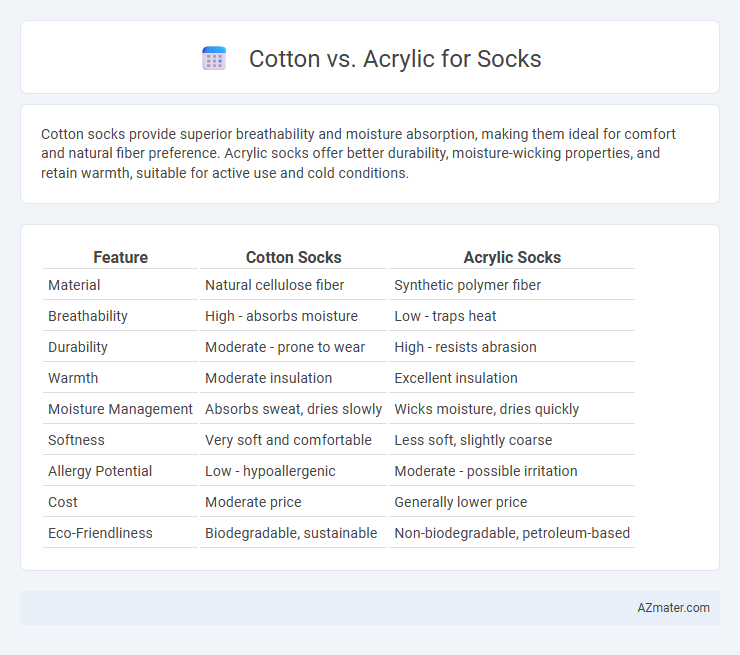Cotton socks provide superior breathability and moisture absorption, making them ideal for comfort and natural fiber preference. Acrylic socks offer better durability, moisture-wicking properties, and retain warmth, suitable for active use and cold conditions.
Table of Comparison
| Feature | Cotton Socks | Acrylic Socks |
|---|---|---|
| Material | Natural cellulose fiber | Synthetic polymer fiber |
| Breathability | High - absorbs moisture | Low - traps heat |
| Durability | Moderate - prone to wear | High - resists abrasion |
| Warmth | Moderate insulation | Excellent insulation |
| Moisture Management | Absorbs sweat, dries slowly | Wicks moisture, dries quickly |
| Softness | Very soft and comfortable | Less soft, slightly coarse |
| Allergy Potential | Low - hypoallergenic | Moderate - possible irritation |
| Cost | Moderate price | Generally lower price |
| Eco-Friendliness | Biodegradable, sustainable | Non-biodegradable, petroleum-based |
Introduction to Cotton and Acrylic Socks
Cotton socks offer superior breathability and natural moisture absorption, making them ideal for everyday wear and sensitive skin. Acrylic socks provide excellent insulation, durability, and quick-drying properties, often used for athletic activities and cold weather. Both materials serve distinct purposes in sock manufacturing, balancing comfort, performance, and maintenance requirements.
Material Composition: Cotton vs Acrylic
Cotton socks are made from natural fibers, offering breathability, moisture absorption, and softness, which helps prevent foot odor and irritation. Acrylic socks consist of synthetic fibers that provide warmth, durability, and quick-drying properties, making them suitable for cold or wet conditions. The choice between cotton and acrylic for socks depends on the desired comfort, moisture management, and environmental considerations.
Comfort and Feel: Softness and Texture
Cotton socks offer superior softness and breathability, providing a natural, smooth texture that reduces irritation and enhances comfort during extended wear. Acrylic socks, while less breathable, provide a lightweight and softer feel compared to wool, but often lack the natural moisture-wicking properties and gentle touch of cotton fibers. The plushness of cotton makes it ideal for sensitive skin, whereas acrylic can feel slightly synthetic and less cozy over long periods.
Breathability and Moisture-Wicking Properties
Cotton socks offer natural breathability, allowing air to circulate and keep feet cool, but they tend to retain moisture, which can lead to discomfort and blisters during prolonged wear. Acrylic socks excel in moisture-wicking by drawing sweat away from the skin to the fabric's surface where it evaporates quickly, keeping feet dry and reducing the risk of fungal infections. Choosing acrylic socks is ideal for activities requiring sustained moisture management, while cotton socks provide softness and comfort for casual, dry conditions.
Warmth and Insulation Capabilities
Cotton socks provide moderate warmth and breathability but tend to retain moisture, reducing insulation efficiency in cold conditions. Acrylic socks offer superior warmth and insulation due to their moisture-wicking properties and ability to retain heat even when damp. For cold-weather activities, acrylic socks are preferred for maintaining dry, insulated feet.
Durability and Longevity of Each Material
Cotton socks offer natural breathability and moisture absorption but tend to wear out faster due to fiber breakage and shrinking over time. Acrylic socks provide superior durability with excellent resistance to abrasion, retaining shape and color even after repeated washes. The synthetic nature of acrylic fibers enhances longevity, making them a preferred choice for heavy-use or athletic socks.
Hypoallergenic and Skin Sensitivity Considerations
Cotton socks are naturally hypoallergenic, making them ideal for individuals with sensitive skin or allergies, as they allow better breathability and reduce irritation. In contrast, acrylic fibers can sometimes cause skin sensitivity due to their synthetic nature and lower moisture-wicking properties, which may lead to discomfort or allergic reactions. Choosing cotton over acrylic reliably supports healthier skin by minimizing contact with potential irritants and maintaining dryness.
Maintenance and Care: Washing and Drying
Cotton socks require gentle washing with mild detergent and should be air-dried to prevent shrinkage and maintain softness, as high heat can damage fibers. Acrylic socks are more durable in machine washing and can tolerate tumble drying on low heat without losing shape or color. Proper maintenance of cotton socks ensures breathability and comfort, while acrylic socks offer ease of care and quick drying for active lifestyles.
Environmental Impact: Sustainability Comparison
Cotton socks typically have a higher environmental footprint due to water-intensive cultivation and pesticide use, though organic cotton offers a more sustainable alternative. Acrylic socks, derived from petroleum-based polymers, contribute to fossil fuel depletion and generate microplastic pollution during washing. Choosing socks made from organic cotton or recycled materials can significantly reduce environmental impact while maintaining comfort and durability.
Best Uses and Recommendations for Each Sock Type
Cotton socks are ideal for everyday wear and moderate physical activity due to their breathability, moisture-wicking properties, and softness, which help keep feet dry and comfortable. Acrylic socks excel in cold weather and high-altitude conditions by providing superior insulation, durability, and quick-drying features, making them suitable for outdoor activities like hiking and skiing. For optimal performance, choose cotton socks for casual, office, or low-impact activities, and opt for acrylic socks when warmth, moisture management, and resilience are priorities in demanding environments.

Infographic: Cotton vs Acrylic for Sock
 azmater.com
azmater.com